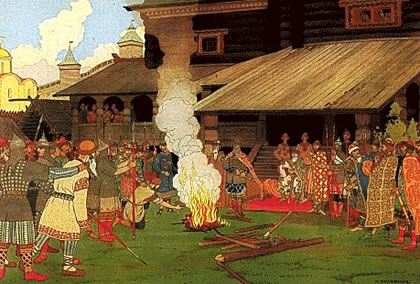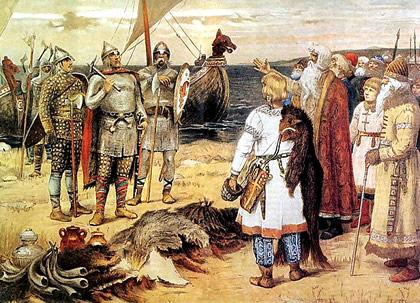World History
Vikings (Rus in the Arabic and Varangians in the Greek sources), primarily from central Sweden and the Isle of Gotland, first entered northwestern Russia by way of the Gulf of Finland, the Neva River, and Lake Ladoga, in small exploratory groups in the mid-eighth century.
By c. 850 the Vikings had established a complex commercial network stretching from Lake Ladoga to the Islamic caliphate and, by the early 10th century, had already extended their reach southward to the Byzantine Empire via Kiev, and east through intermediaries along the middle Volga in Bulgaria.
From this tribute-taking merchant diaspora emerged a core group that settled permanently in places such as Novgorod and Kiev, gradually became acculturated with the Slavs, and helped found the first East Slavic kingdom, Kievan Rus, in the 10th century.
The main source for the Vikings in Russia, The Russian Primary Chronicle, tells that in 862 the Viking Riurik and his kin were invited by Slavic and Finnic tribes to come and rule over them, developing a tributary tax system stretching from northwestern Russia to the upper and middle Dnieper River regions.
The chronicle’s account is substantiated by finds of Scandinavian-style artifacts (tortoiseshell brooches, Thor’s hammer pendants, wooden idols, weapons) and, in some cases graves, located at the tribal centers and riverside way stations of Staraia Ladoga, Riurikovo Gorodishche, Siaskoe Gorodishche, Timerevo, and Gnezdovo. The Volkhov-IlmenDnieper river route, which linked the eastern Baltic with the Byzantine Empire, is known as “the Route from the Varangians to the Greeks.â€
In contrast to Viking activity in the west, which was characterized primarily by raiding and large-scale colonization, the Rus town network and subsequent tribal organization were designed for trade. Subject tribes living along river systems supplied the Rus with the furs, wax, honey, and slaves that they would further exchange for Islamic silver coins (dirhams), glass beads, silks, and spices in southern markets.

The Rus expansion into Byzantine markets began in earnest in the early 10th century, with Rus attacks on Constantinople in 907, 911, and 944, resulting in trade agreements.
By the end of the century, c. 988, Vladimir I (Vladimir the Great) (980–1015), a quarter Viking through his father Sviatoslav, had married into the Byzantine royal family and converted to Byzantine Christianity, thereby laying the foundation for the Eastern Slavic relationship with the Greek world.
The 10th century marked the high point of Viking involvement in the east. Much of the Scandinavian-style jewelry found in European Russia and a majority of the Scandinavian-style graves date to the second and third quarters of the 10th century. Vladimir I and his son Yaroslav the Wise (1019–54) enlisted Viking mercenary soldiers such as Harald Hardrada in internecine dynastic wars.
In the 11th century, however, the Viking footsoldier armies had become obsolete as the Rus princes were forced to adapt to another enemy in the south, the Turkic nomads who fought on horseback. A nomadic army on horseback defeated Yaroslav’s Viking mercenaries at the Battle of Listven (1024).
- Vladimir I (vladimir The Great)
Vladimir I (Vladimir the Great)Vladimir was a descendant of the ninth century Scandinavian chieftain Rurik, whose successors established control along the Dnieper and other river routes that connected Scandinavia to the Black Sea. Kiev became the political...
- Yaroslav The Wise
Yaroslav the WiseAlso called Iaroslav, or Yaroslav Mudryi in Russian, Yaroslav the Wise was grand prince of Kiev from 1019 to 1054, one of the brightest representatives of the Riurykide (Rurikovich) dynasty, who was best known in eastern European history...
- Birka: Trade Center And Gateway For Viking Age Sweden
Birka: Trade Center and Gateway for Viking Age Sweden. Recounts the story of this town in Sweden founded in the 8th century on the island of Björkö. Includes maps, a reconstruction drawing, and description of Birka in the Viking age. This is from a...
- History Of Russia
History of Russia. This is a history of the European and Asian nation of Russia. It has been a world power several times in the past and it may well be so again in the future. It also has long had the distinction (as Russia or the Soviet Union) of being...
- Vikings
Vikings - BBC Online presents aspects of the history of the Vikings in the British Isles. Includes dig reports, 3D model of a Viking age farm at Ribblehead, Yorkshire, and fun approaches for kids. From the site: The Vikings have left many traces...
World History
Vikings in Russia
 |
| Vikings in Russia |
Vikings (Rus in the Arabic and Varangians in the Greek sources), primarily from central Sweden and the Isle of Gotland, first entered northwestern Russia by way of the Gulf of Finland, the Neva River, and Lake Ladoga, in small exploratory groups in the mid-eighth century.
By c. 850 the Vikings had established a complex commercial network stretching from Lake Ladoga to the Islamic caliphate and, by the early 10th century, had already extended their reach southward to the Byzantine Empire via Kiev, and east through intermediaries along the middle Volga in Bulgaria.
From this tribute-taking merchant diaspora emerged a core group that settled permanently in places such as Novgorod and Kiev, gradually became acculturated with the Slavs, and helped found the first East Slavic kingdom, Kievan Rus, in the 10th century.
  |   |
The main source for the Vikings in Russia, The Russian Primary Chronicle, tells that in 862 the Viking Riurik and his kin were invited by Slavic and Finnic tribes to come and rule over them, developing a tributary tax system stretching from northwestern Russia to the upper and middle Dnieper River regions.
The chronicle’s account is substantiated by finds of Scandinavian-style artifacts (tortoiseshell brooches, Thor’s hammer pendants, wooden idols, weapons) and, in some cases graves, located at the tribal centers and riverside way stations of Staraia Ladoga, Riurikovo Gorodishche, Siaskoe Gorodishche, Timerevo, and Gnezdovo. The Volkhov-IlmenDnieper river route, which linked the eastern Baltic with the Byzantine Empire, is known as “the Route from the Varangians to the Greeks.â€
In contrast to Viking activity in the west, which was characterized primarily by raiding and large-scale colonization, the Rus town network and subsequent tribal organization were designed for trade. Subject tribes living along river systems supplied the Rus with the furs, wax, honey, and slaves that they would further exchange for Islamic silver coins (dirhams), glass beads, silks, and spices in southern markets.

The Rus expansion into Byzantine markets began in earnest in the early 10th century, with Rus attacks on Constantinople in 907, 911, and 944, resulting in trade agreements.
By the end of the century, c. 988, Vladimir I (Vladimir the Great) (980–1015), a quarter Viking through his father Sviatoslav, had married into the Byzantine royal family and converted to Byzantine Christianity, thereby laying the foundation for the Eastern Slavic relationship with the Greek world.
The 10th century marked the high point of Viking involvement in the east. Much of the Scandinavian-style jewelry found in European Russia and a majority of the Scandinavian-style graves date to the second and third quarters of the 10th century. Vladimir I and his son Yaroslav the Wise (1019–54) enlisted Viking mercenary soldiers such as Harald Hardrada in internecine dynastic wars.
In the 11th century, however, the Viking footsoldier armies had become obsolete as the Rus princes were forced to adapt to another enemy in the south, the Turkic nomads who fought on horseback. A nomadic army on horseback defeated Yaroslav’s Viking mercenaries at the Battle of Listven (1024).
- Vladimir I (vladimir The Great)
Vladimir I (Vladimir the Great)Vladimir was a descendant of the ninth century Scandinavian chieftain Rurik, whose successors established control along the Dnieper and other river routes that connected Scandinavia to the Black Sea. Kiev became the political...
- Yaroslav The Wise
Yaroslav the WiseAlso called Iaroslav, or Yaroslav Mudryi in Russian, Yaroslav the Wise was grand prince of Kiev from 1019 to 1054, one of the brightest representatives of the Riurykide (Rurikovich) dynasty, who was best known in eastern European history...
- Birka: Trade Center And Gateway For Viking Age Sweden
Birka: Trade Center and Gateway for Viking Age Sweden. Recounts the story of this town in Sweden founded in the 8th century on the island of Björkö. Includes maps, a reconstruction drawing, and description of Birka in the Viking age. This is from a...
- History Of Russia
History of Russia. This is a history of the European and Asian nation of Russia. It has been a world power several times in the past and it may well be so again in the future. It also has long had the distinction (as Russia or the Soviet Union) of being...
- Vikings
Vikings - BBC Online presents aspects of the history of the Vikings in the British Isles. Includes dig reports, 3D model of a Viking age farm at Ribblehead, Yorkshire, and fun approaches for kids. From the site: The Vikings have left many traces...
